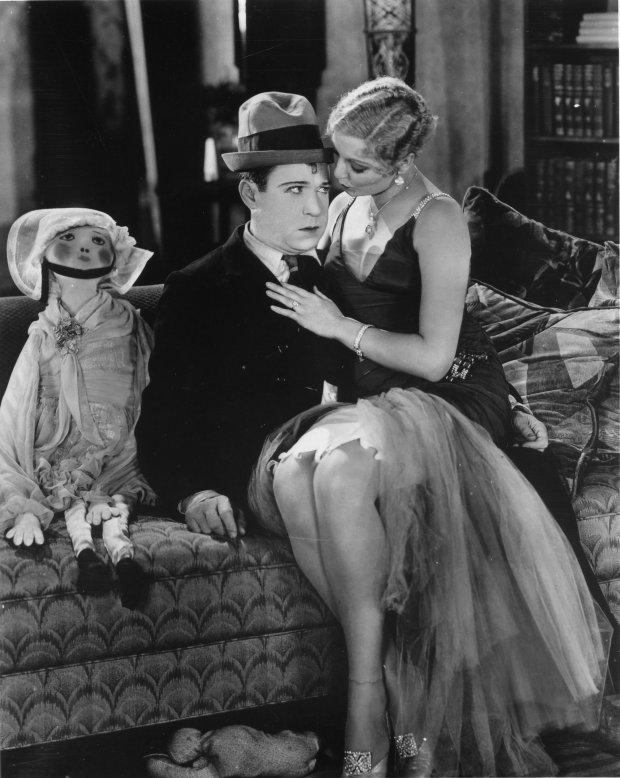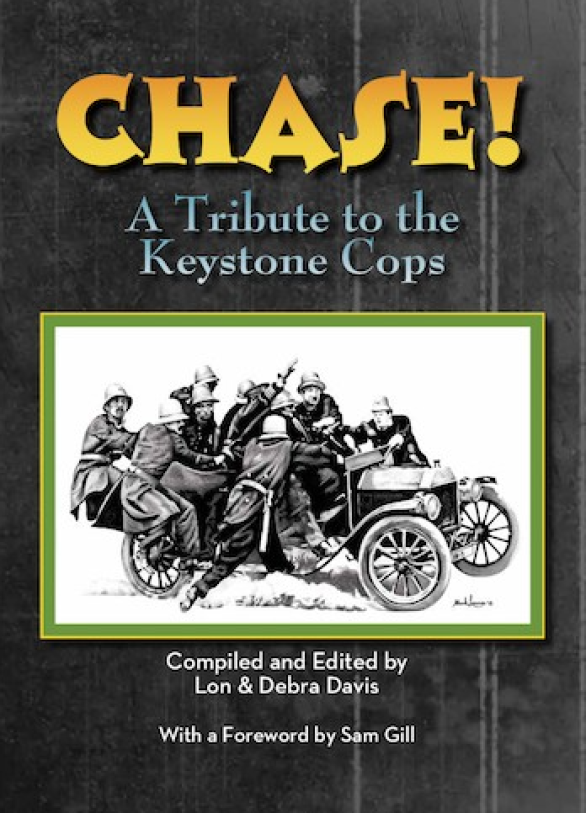This article previously appeared in Issue 8 of Movie Night/The Lost Laugh Magazine. After finding out a bit more information, I’ve reproduced it here with updates.

Harry Langdon: The ‘Little Elf’ grown up with a moustache in the late ’30s

Naughton & Gold: ‘The Napoleons of Fun!”
Some of the most intriguing moments in the history of any art form are those where paths of prominent artists meet. Sometimes, these are premeditated collaborations between heavyweight artists. At other times, they are more coincidental, dictated by circumstance.
The era of classic comedies brought about many such occurrences. Buster Keaton and Charlie Chaplin performing a routine in ‘LIMELIGHT’ is perhaps the most famous; Roscoe Arbuckle’s partnership with Keaton the most productive. Charley Chase guesting in Laurel and Hardy’s ‘SONS OF THE DESERT’ is perhaps the most beloved. Less high-profile, these encounters became more and more frequent as silent comedy became a niche of ever decreasing circles. Stars on their way down clustered together to make a living, for at Educational pictures and Columbia for instance, and later on television. Thus, in later years we get Buster Keaton directed by Mack Sennett, Snub Pollard supporting the Three Stooges, and Keaton with Billy Gilbert on TV, amongst many others. Some of these obscure, ephemeral appearances are among the most interesting for comedy devotees, if not the most entertaining.
One to definitely file under this curiosity category is ‘WISE GUYS’ (1937). This is a long-vanished British film, directed by none other than comedy great Harry Langdon and starring an obscure team of Music Hall comedians! Just the notion of Langdon, who directed few films, helming a British film of the 30s, is bizarre in itself. So how did this come about?
Contrary to the myths perpetrated by Frank Capra and others, Langdon was far from hapless in the sound era. He had starred in many successful short films throughout the late 20s and early 30s. Whilst his hopes for a full comeback remained unfulfilled, he remained popular and visible in supporting roles in a variety of features. By 1936, this work had started to dry up a little however, and for a change of pace he took up with a stage show, ‘ANYTHING GOES’. The play, in which he played a comically bumbling gangster, took a year-long tour to Australia. This was very successful, and the presence of a Hollywood star was rare indeed. In contrast to the USA, Langdon was feted by the press.
After a successful stay, and without too much demand at home, he found himself taking a leisurely wayward journey back to the states. With wife Mabel and son Harry, Jr in tow, they saw a little of Paris and then travelled on to London. Whilst there, Harry obtained a small part in a musical, ‘STARDUST’ (re-released as both ‘MAD ABOUT MONEY’ and ‘HE LOVED AN ACTRESS’) with Ben Lyon, and also found himself asked to direct a film.
Quite how this came about is lost to time, although possibly through the influence of Ben Lyon, who was an old co-star of Harry’s. In the fumbling British B-picture industry of the 1930s, the presence of any Hollywood stars was seen as something of a coup. ‘STARDUST’, featuring Lyons and Langdon as well as Lupe Velez, was just one example of this kind of ‘booster’ film, and probably someone connected with the production saw a chance to cash in on Langdon’s name.
The stars were Charley Naughton and Jimmy Gold, a long standing Scots comedy team. They had a history on the Music Halls dating back to 1908 and were considered real veterans. In the mid-30s they were finding a new prominence as members of ‘THE CRAZY GANG’. Alongside the other teams of Flanagan & Allen and Nervo & Knox, they starred in a series of successful shows at the Palladium, as well as branching into film.
The Crazy Gang have been referred to as ‘The English Marx Brothers’, but this isn’t really a very accurate assessment. Though they shared with the Marxes a penchant for excruciating puns, their humour was much less cerebral. It was certainly lively and boisterous, though, a high-spirited mixture of slapstick, word play, cross-talk and jokes that creaked like the deck of a ghost ship.
Flanagan and Allen proved the most enduring of the constituent teams, with a creative line in fumbling wordplay, based on the lovably bedraggled Flanagan’s attempt to pronounce words:
Naughton and Gold are probably the lesser lights of The Crazy Gang. They chatter away in Scottish accents, and witter around not doing anything especially funny, at least in the films. One of the problems with The Crazy Gang was that its individual members were sometime lost in the chaos; Naughton and Gold, as the least distinictive comedians, suffered the worst from this.
Their records, without the other members of the gang, allowed them more prominence. These tend to play on their Scottish heritage, such as ‘IN SEARCH OF THE LOCH NESS MONSTER’. Their modus operandi in sketches like this veers much more to creaky puns than to character. Examples like this would make Chico Marx wince:
“That monster must weigh half a ton.”
“How do you know?”
“I saw the scales on his back…”
The problem with this sort of comedy is that it needs to be delivered with the knowing slyness of Groucho or Chico. With a few exceptions, Brit comedians of the time, like Naughton and Gold, were mostly just too polite to have the audacity to really deliver these puns. (Flanagan and Allen are an exception – they got away with it by acknowledging the awfulness of the punchlines with their cry of “Oi!” at the jokes’ conclusions).
Despite their failings on film and record, it could be that these just weren’t the right media to capture Naughton and Gold. They were stage comedians first and foremost, with 30 years experience polishing their act. This longevity must speak for a certain amount of skill. Originally debuting as tap dancers, they subsequently shifted their athleticism toward slapstick. Gold came from a family trade of painters and decorators, and the duo’s most praised act centred on paste and paper slapstick. Inevitably, in the time their films date from, they were getting on in years; we know them from a time when they were trading more on dated whimsy than slapstick. Among the louder members of the Crazy Gang, this is somewhat lost. Whether or not they fared better in their ‘solo’ starring vehicles is hard to say now, as both ‘HIGHLAND FLING’ (1936) and ‘WISE GUYS’ have vanished. Both were made for the cheapie studio Fox British, which churned out ‘Quota Quickies’, films made quickly to satisfy a ruling that a percentage of films shown in Britain must be made domestically.
The context of the manufacture doesn’t make one hold out great hope for the quality of ‘WISE GUYS’, but who knows? Langdon had common ground with Naughton and Gold in whimsy, visual humour and a long history of stage training prior to films. Charlie Naughton’s character had some similarities with Langdon’s ‘little elf’, with a curious mixture of middle aged man and pudgy baby about him. Indeed, he was often the put-upon child-figure of the Crazy Gang. Perhaps Langdon adapted some comic bits for him.
The story of WISE GUYS is another play on Naughton & Gold’s Scottish origins. As extreme spendthrifts, they find themselves related to a rich racehorse owner, Phineas MacNaughton (Robert Nainby), and determine to prove themselves members of the rich family. Unfortunately, this involves them – shudder – spending money! The few stills I’ve managed to track down show them trying to show themselves splashing out in a fancy restaurant, and . Unfortunately, their efforts are all in vain as they are pipped to getting a piece of the racehorse, and the family fortune, by their cousin Audrene Brier. The boys are kicked out of the house and return to spendthrift happiness.
The story has potential for some good sequences, and plenty of fish-out-of-water comedy. One particularly amusing still shows the pair in the swanky restaurant, trying to show off living the high life, but still on a budget: they have ordered the tiniest roast chicken ever seen:

The overall success of ‘WISE GUYS’ would have been limited by the rushed shooting schedule and limited budget. Langdon’s direction has also been a bone of long contention. At this point, he hadn’t directed a film since 1933’s ragbag short ‘THE STAGE HAND’ (cobbled together from outtakes from a planned feature, THE SHOW GOAT), and had not helmed a feature since 1928’s HEART TROUBLE, the film that was effectively his last as a major star. Langdon’s own direction has often been cited as the reason for his crash-and-burn from stardom, though THREE’S A CROWD and ‘THE CHASER’ have picked up many fans in recent years following DVD release. The jury is still out on his skills as director, though it’s important to note that, like Stan Laurel, he was the unofficial director on many of his films. His idiosyncratic style so set the style and pace of most of his films, that he had an influence way above that of star. ‘WISE GUYS’ is the only time he directed other comedians, which makes its disappearance that more frustrating. However, the following piece, syndicated in The Bournemouth Graphic on May 7th, 1937, presents an on-set account of Langdon directing the film – one of the very few first-hand accounts of him at work in the director’s chair. Most interesting is the quote that “watching [Langdon] work, it made me realise just how important the director is in making a comedy and just how little credit he gets.” (Irony of ironies, the writer then goes on to make a comparison to the work of Frank Capra!). Clearly, Langdon was in full control of proceedings, and adding his own comedy touches. Here’s the full piece:

For what it’s worth, The Era’s positive review of WISE GUYS on 12 August, 1937, stated that “Mr Langdon’s handling of the material is in the best tradition of Hollywood’s laugh-winning skill.”
WISE GUYS would be the last film that Langdon directed. Following completion, he headed back to the States, and would live with Stan Laurel for a while while he sorted out work. Laurel would lead him to more behind-the-scenes work, at Hal Roach Studios. After writing for L & H’s ‘BLOCKHEADS’ he would find himself at another of those curious cinematic crossroads. In 1939 he starred with Oliver Hardy in ‘ZENOBIA’, after Roach fired Laurel. Despite this, the Laurel-Langdon friendship remained firm until Harry’s untimely death in 1944.
As for Naughton and Gold, the Crazy Gang concept now gathered steam, with their 1937 film ‘O-KAY FOR SOUND’ being a smash. They would make a run of other successful comedies together, including ‘ALF’S BUTTON AFLOAT’ and ‘THE FROZEN LIMITS’, as well as a long, long run of stage shows lasting to the early 1960s. Making their final performance together in 1962, Naughton and Gold secured a record as the longest running double act in British history: 54 years!
In that lengthy career, ‘WISE GUYS’ was a mere brief moment. It’s unlikely that this long forgotten feature was an out and out classic. Nevertheless, it would be fascinating to see the fruit borne by this unlikely meeting of comic minds.


 It came! After weeks of waiting for Trans-Atlantic deliveries to return to normality, yesterday HARRY LANGDON AT HAL ROACH: THE TALKIES 1929-30 finally dropped into my mailbox.
It came! After weeks of waiting for Trans-Atlantic deliveries to return to normality, yesterday HARRY LANGDON AT HAL ROACH: THE TALKIES 1929-30 finally dropped into my mailbox.




